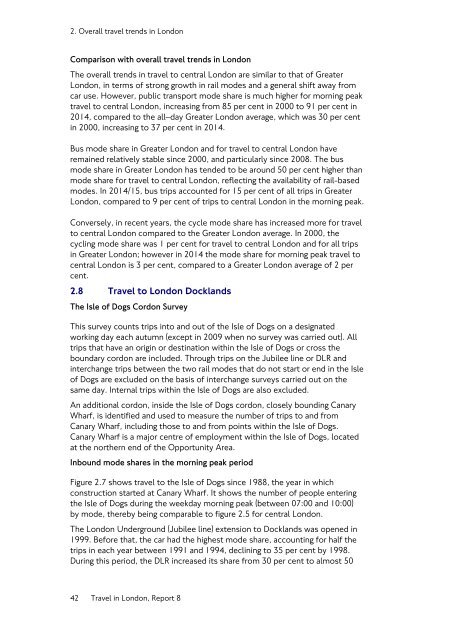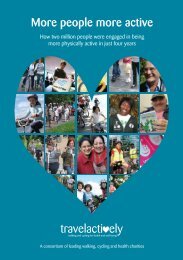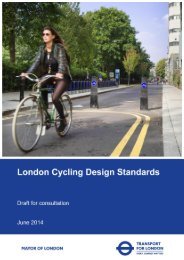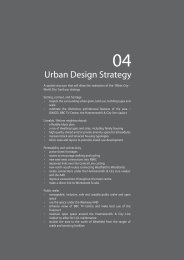Travel in London Travel in London
travel-in-london-report-8
travel-in-london-report-8
You also want an ePaper? Increase the reach of your titles
YUMPU automatically turns print PDFs into web optimized ePapers that Google loves.
2. Overall travel trends <strong>in</strong> <strong>London</strong><br />
Comparison with overall travel trends <strong>in</strong> <strong>London</strong><br />
The overall trends <strong>in</strong> travel to central <strong>London</strong> are similar to that of Greater<br />
<strong>London</strong>, <strong>in</strong> terms of strong growth <strong>in</strong> rail modes and a general shift away from<br />
car use. However, public transport mode share is much higher for morn<strong>in</strong>g peak<br />
travel to central <strong>London</strong>, <strong>in</strong>creas<strong>in</strong>g from 85 per cent <strong>in</strong> 2000 to 91 per cent <strong>in</strong><br />
2014, compared to the all–day Greater <strong>London</strong> average, which was 30 per cent<br />
<strong>in</strong> 2000, <strong>in</strong>creas<strong>in</strong>g to 37 per cent <strong>in</strong> 2014.<br />
Bus mode share <strong>in</strong> Greater <strong>London</strong> and for travel to central <strong>London</strong> have<br />
rema<strong>in</strong>ed relatively stable s<strong>in</strong>ce 2000, and particularly s<strong>in</strong>ce 2008. The bus<br />
mode share <strong>in</strong> Greater <strong>London</strong> has tended to be around 50 per cent higher than<br />
mode share for travel to central <strong>London</strong>, reflect<strong>in</strong>g the availability of rail-based<br />
modes. In 2014/15, bus trips accounted for 15 per cent of all trips <strong>in</strong> Greater<br />
<strong>London</strong>, compared to 9 per cent of trips to central <strong>London</strong> <strong>in</strong> the morn<strong>in</strong>g peak.<br />
Conversely, <strong>in</strong> recent years, the cycle mode share has <strong>in</strong>creased more for travel<br />
to central <strong>London</strong> compared to the Greater <strong>London</strong> average. In 2000, the<br />
cycl<strong>in</strong>g mode share was 1 per cent for travel to central <strong>London</strong> and for all trips<br />
<strong>in</strong> Greater <strong>London</strong>; however <strong>in</strong> 2014 the mode share for morn<strong>in</strong>g peak travel to<br />
central <strong>London</strong> is 3 per cent, compared to a Greater <strong>London</strong> average of 2 per<br />
cent.<br />
2.8 <strong>Travel</strong> to <strong>London</strong> Docklands<br />
The Isle of Dogs Cordon Survey<br />
This survey counts trips <strong>in</strong>to and out of the Isle of Dogs on a designated<br />
work<strong>in</strong>g day each autumn (except <strong>in</strong> 2009 when no survey was carried out). All<br />
trips that have an orig<strong>in</strong> or dest<strong>in</strong>ation with<strong>in</strong> the Isle of Dogs or cross the<br />
boundary cordon are <strong>in</strong>cluded. Through trips on the Jubilee l<strong>in</strong>e or DLR and<br />
<strong>in</strong>terchange trips between the two rail modes that do not start or end <strong>in</strong> the Isle<br />
of Dogs are excluded on the basis of <strong>in</strong>terchange surveys carried out on the<br />
same day. Internal trips with<strong>in</strong> the Isle of Dogs are also excluded.<br />
An additional cordon, <strong>in</strong>side the Isle of Dogs cordon, closely bound<strong>in</strong>g Canary<br />
Wharf, is identified and used to measure the number of trips to and from<br />
Canary Wharf, <strong>in</strong>clud<strong>in</strong>g those to and from po<strong>in</strong>ts with<strong>in</strong> the Isle of Dogs.<br />
Canary Wharf is a major centre of employment with<strong>in</strong> the Isle of Dogs, located<br />
at the northern end of the Opportunity Area.<br />
Inbound mode shares <strong>in</strong> the morn<strong>in</strong>g peak period<br />
Figure 2.7 shows travel to the Isle of Dogs s<strong>in</strong>ce 1988, the year <strong>in</strong> which<br />
construction started at Canary Wharf. It shows the number of people enter<strong>in</strong>g<br />
the Isle of Dogs dur<strong>in</strong>g the weekday morn<strong>in</strong>g peak (between 07:00 and 10:00)<br />
by mode, thereby be<strong>in</strong>g comparable to figure 2.5 for central <strong>London</strong>.<br />
The <strong>London</strong> Underground (Jubilee l<strong>in</strong>e) extension to Docklands was opened <strong>in</strong><br />
1999. Before that, the car had the highest mode share, account<strong>in</strong>g for half the<br />
trips <strong>in</strong> each year between 1991 and 1994, decl<strong>in</strong><strong>in</strong>g to 35 per cent by 1998.<br />
Dur<strong>in</strong>g this period, the DLR <strong>in</strong>creased its share from 30 per cent to almost 50<br />
42 <strong>Travel</strong> <strong>in</strong> <strong>London</strong>, Report 8








